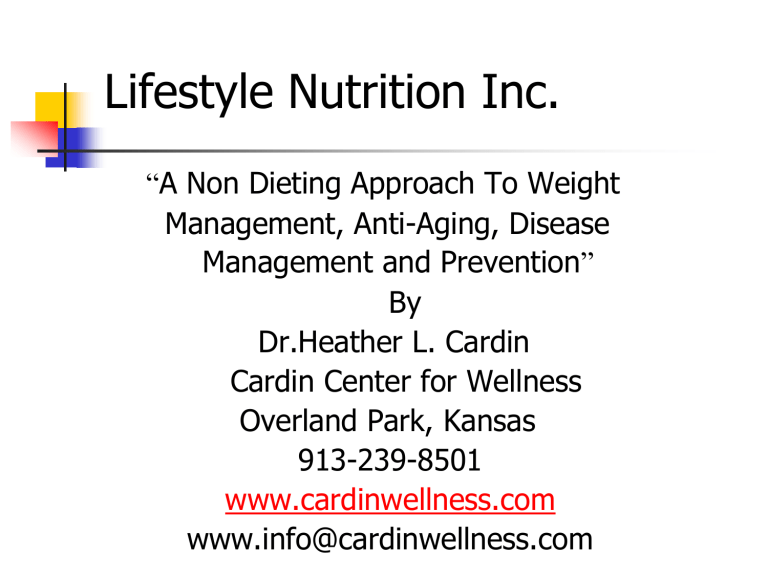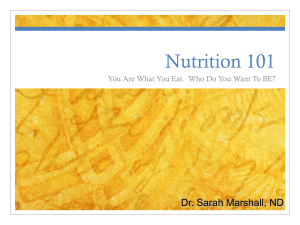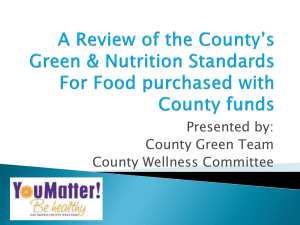Lifestyle Nutrition Inc. - Cardin Center for Wellness

Lifestyle Nutrition Inc.
“ A Non Dieting Approach To Weight
Management, Anti-Aging, Disease
Management and Prevention ”
By
Dr.Heather L. Cardin
Cardin Center for Wellness
Overland Park, Kansas
913-239-8501 www.cardinwellness.com
www.info@cardinwellness.com
Levels of Alternative Therapies
For Anti-Aging
Allopathic Medicine : Medications for Symptoms ie aspirin, statins, Beta-blockers , ACEI etc
Complementary Therapies : diet, exercise, fats, protein, carbohydrates functional foods such as soy, fiber, fish oils, nuts, anti-oxidants,
LIFESTYLE CHANGES
Alternative Therapies : herbs, garlic, red yeast,
Artichoke & Green Tea extracts, homeopathic supplements
Anti-Aging Therapies : Qi Gong, chelation, hormone replacement, ie growth hormone, testosterone or Nutritional products ie, growth factors, glandular products.
What is Anti - Aging from a
Dietetics Standpoint?
Fitness, Wellness and Lifestyle Management -
Motivation
Understanding Relationship of Aging &
Diseases
Nutrition, Exercise, Stress Reduction
Body Composition Analysis
Nutritional Supplements
It ’ s A Lifestyle..Not A Diet! TM
Lifestyle Nutrition's
Ant-Aging Program
We will Develop Your Program Based on:
LBM , % Body Fat
Your Metabolic Rate
Age, Sex, Activity Level
Blood Labs – Thyroid, Lipids, FBG, CRP, Homocystein
Your Medical or Nutritional Goals
Your Lifestyle & Preferences
No Food Restrictions, No Food Weighing,
No Counting Points
Lifestyle Nutrition's Anti-Aging
Program
We will Focus on:
Blood Sugar Mgt. – Digestion & Absorption Time
Animal vs Plant Protein
Type & Amount CHO
Sat. vs Unsat. Fats
Cis vs Trans Fats
Soluble vs Insoluble Fiber
Restaurant & Travel Eating
Realistic Exercise Program
Stress Reduction
Goal of the Lifestyle Nutrition
Program
Improve Hair Skin & Nails
Reduce Body Fat & Increase Lean Muscle
Raise Metabolism Naturally – without stimulants
Improve Energy Level, Mood, Reduce Fatigue
Have more variety of food & reduce cravings, & appetite.
Improve Immune System, Reduce Disease Risk
Save Time & Reduce Stress
Finally, Understand the Science of Nutrition for You -
All With Food & Nutritional Supplements
Average Life Span
1700 ’ s 30 years
1800 ’ s 46 years
1900 ’ s 80 years
Primary Causes of Death
1900 Infections
1990 Cardiovascular Disease & Cancer
Current Projected Life Span - 120 years old
Definition of Health
1900 ’ s Absence of Disease
1920 ’ s Normal Functioning of the Body
Today Improving the quality and quantity of your life, involving a complete physical, intellectual, spiritual, and social well being.
Not Just the Absence of Disease Anymore
How Drugs Effect
Nutritional Status
Approximately 34 million Americans are 65 years or older yet they consume 30% of all medications.
Average patient taking 3 to 7 medications at one time.
Medications alter food intake, absorption, metabolism and excretion of nutrients.
Decrease appetite, taste and smell.
May cause GI disturbances such as reflux, nausea, constipation, and/or diarrhea or Liver
Toxicity and many more side effects.
Blood
Sugar
Levels
High Blood Sugar
Make Fat
Typical American Diet
Blood Sugar
High Blood Sugar
Make Fat
7:00 AM
Breakfast
Low Blood Sugar
Burn Muscle
12:00 P.M
Lunch
Low Blood Sugar
Tired, Irritable, Moody,
Depressed, Hungry,
Cravings
7:00 P.M
Dinner
Blood
Sugar
Levels
Lifestyle Nutrition Program
Concentrates On Blood Sugar Mgt.
Not Calorie Counting or Weighing Food
With Anti - Aging Foods & Nutritional Supplementation
Avoid High Blood Sugar Excess Synthesis of Insulin, Make Fat
Feed Metabolism, Increase Lean Muscle, No Cravings, Appetite or Irritability
Avoid Low Blood Sugar Reduce Fatigue & Muscle Loss
Hidden Weight Gain
A typical Man eats over 1 million calories a year
If extra 10/day ---> gain 1 lb fat in a year
If extra 100/day ---> gain 10 lbs in yr.
100 kcals is about 1 apple, 2 tsp butter
In 5 years could add up to extra 5-50 lbs
Chronic, small excess in calories , can lead to substantial excess weight gain over time
Energy Balance
Input
Output
Basal Metabolism (70-75% of calories)
Diet Induced Thermo genesis or SDA
Activity of Daily Living
Calories Utilized by Exercise
Thyroid Disorders
American Aging Process
Metabolic Syndrome - Insulin Resistance
Blood
Sugar
MGT
Loss Of
Lean Muscle
Increased
Body Fat
(Abdominal)
Insulin
Resistance Stress
Pre - Diabetes
Diet
Increased
Blood Lipids
HTN exercise
Diabetes
Cardiovascular
Disease
Cancer
95% of Type II Diabetes Lifestyle & Diet controlled, 5% due to Genetic Factors
67% of Cancer from Lifestyle Risk & Diet , 33% from Genetics
Nutrition and Aging
Body composition and your basal metabolism and its effects on calories and energy .
Do I have enough lean mass to adequately conduct thermogenisis – burn calories.
What is a realistic goal weight for my body, based on my lean muscle mass?
Body Mass Index
WEIGHT lbs
HEIGHT
10
0
10
5
11
0
11
5 120
12
5
13
0
13
5
14
0
14
5
15
0
15
5
16
0
16
5
17
0
175
5 ’ 0 ” 20 21 21 22 23 24 25 26 27 28 29 30 31 32 33 34
5 ’ 1 ” 19 20 21 22 23 24 25 26 26 27 28 29 30 31 32 33
5 ’ 2 ” 18 19 21 22 22 23 24 25 26 27 27 28 29 30 31 32
5 ’ 3 ” 18 19 20 21 21 22 23 24 25 26 27 27 28 29 30 31
5 ’ 4 ” 17 18 20 21 21 21 22 23 24 25 26 27 27 28 29 30
5 ’ 5 ” 17 17 19 20 20 21 22 22 23 24 25 26 27 27 28 29
5 ’ 6 ” 16 17 19 19 19 20 21 22 23 23 24 25 26 27 27 28
5 ’ 7 ” 16 16 18 19 19 20 20 21 22 23 23 24 25 26 27 27
5 ’ 8 ” 15 16 17 18 18 19 20 21 21 22 23 24 24 25 26 27
5 ’ 9 ” 15 16 17 18 18 18 19 20 21 21 22 23 24 24 25 26
5 ’ 10 ” 14 15 17 17 17 18 19 19 20 21 22 22 23 24 24 25
5 ’ 11 ” 14 15 16 17 17 17 18 19 20 20 21 22 22 23 24 24
6 ’ 0 ” 14 14 16 16 16 17 18 18 19 20 20 21 22 22 23 24
6 ’ 1 ” 13 14 15 16 16 16 17 18 18 19 20 20 21 22 22 23
6 ’ 2 ” 13 13 15 15 15 16 17 17 18 19 19 20 21 21 22 22
6 ’ 3 ” 12 13 14 14 15 16 16 17 17 18 19 19 20 21 21 22
6 ’ 4 ” 12 13 13 14 15 15 16 16 17 18 18 19 19 20 21 21
Underweight Normal Overweight Obese
Carbohydrate Functions
Energy - all cells use
Some cells (RBC, brain) can use only
CHO until starvation sets in
Needed for effective burning of fat
Needed for protein synthesis.
Fiber, alternative forms of CHO, provides a number of benefit to the digestive tract.
Fiber – because of the chemical makeup insoluble fiber does not get absorbed easily .
Fiber Types & Actions
Soluble or Insoluble
Binding or bulking actions (for cravings & hunger)
Affects risk for:
CAD
Colon Cancer (20 fold difference in rates)
Digestive Problems
Constipation
Diverticulosis, IBS, Crones, Hemorrhoids
Immune Function
Bulking & Chelating Action
Slows absorption & speeds removal
Could replace higher calorie foods, and give feeling of fullness.
Speeds food flow through intestines
less constipation, diverticulosis, hemorrhoids toxins & carcinogens have less contact time
Chelates or combines with
some carcinogens, nitrates – reduce colon cancer risk
bile acid (cholesterol) – reduce CVD risk
Hormones, pesticides & heavy metals
To increase fiber & complex
CHO … & reduce sugars..??
Eat more whole plant foods – fruits, vegetables, legumes & whole grains
Eat less processed foods & “ white ” flours, rice, chips etc.
Drink less soda, fake fruit drinks
Glycemic Index
Measure of a food ’ s relative ability to raise blood glucose levels
Implication – foods with high GI would cause more problems for those with DM, Metabolic
Syndrome or Reactive Hypoglycemia
Higher GI- sugars, potato, rice, carrots
Low GI- dried beans, pasta, whole wheat
But GI affected by size of meal, other foods, health, fat in meal
Glycemic Load – more accurate
Blood Sugar Response to Different Foods
White, Wheat Bread, Low fat Crackers, Yogurt, Black Beans,Vegetables,
Instant Oatmeal, Wheat Bagels, Brown Rice, Snickers Bar
Cornflakes
Low Glycemic Index
Carbohydrates
Legumes such as black, pinto, kidney, soy beans, and lentils, soy milk peanuts.
High protein pasta, unpolished long grain rice, steel cut oats, oat bran, pearled barley.
“ Fiber One ” cereal and All Bran cereal.
Grapefruit, apple, and Snickers Bar
Foods With a High
Glycemic Index
Non-dairy tofu frozen yogurt
Glucose tablets.
French bread, white rice, white bread, instant potatoes, cornflakes, rice cakes, vanilla wafers, donuts, waffles, french fries.
Cakes, jams, jellies, pies, sodas.
Problems With High Protein?
Assoc. with high intakes of meat, cheese & saturated fats.
Often associated with low fruit & vegetable consumption.
Often associated with low fiber intake.
Increases risk for CAD, & Cancers
Initial weight loss from dehydration
When carb ’ s are added back – wt. gain
Proteins
Lean meats, poultry or fish ( Low Fat)
Natural Peanut butter
Cooked legumes (whites beans, lentils, red, black, split peas, low fat cooked)
Part Skim cheeses or 1- 2% Part Skim, egg or egg whites
Low fat cottage or ricotta cheese tuna (packed in water)
Tofu or Soy Burgers
Dairy
18%
Sources of Fat
Grains
10%
Sweets/Frt
10%
Vegetables
6%
Meats
22%
Fats/oils
34%
Meats
Fats/oils
Dairy
Grains
Sweets/Frt
Vegetables
Omega 3 Sources …
Canola Oil, Flax Seed oil
Cold Water Fish, Shellfish
Tuna (white/albacore or bluefin)
Mackerel & Bluefish
Salmon; sturgeon
Lake trout & whitefish
Not farm raised fish
Antioxidants: Oxidative Stress
95-98% of molecular oxygen taken up by cells is reduced to water.
2-5% of O2 gives rise to reactive free radicals that can be toxic to cell membranes & lead to cell death.
These free radicals have been implicated in the pathogenesis of many degenerative disease processes, including vascular disease.
Oxidative modification of circulating LDL-C turn it into smaller, denser LDL-C which penetrate vascular endothelium and set up the process of atherosclerosis.
Foods High in Phytochemicals
Soy; tomatoes, garlic, onions, legumes, green tea; cruciferous vegetables, red wine, grapes
EAT MORE AND WIDER VARIETY OF
FRUITS & VEGETABLES
Exercise Facts
In U.S., only 10-20% of adults get adequate exercise; 40% no exercise & 40% too little
Drop out rate at most health clubs=70%
**Physically active have about 25% greater physiological function
Generally, peak at 20-30 (muscle & bone)
**While all measures decline with age, exercise can produce a person who is 20 to
30 years younger than that of sedentary person.
“ Benefits ” of exercise
Increase strength Lean Mass - Muscle
(including heart), energy balance (wt control), flexibility, quality of life
Improve CV fitness – increase HDL, VO2 max, decrease blood pressure
Decrease stress, risk of osteoporosis, obesity, & some cancers
** Biggest gain in reduced mortality when exercise 3 times a week
ETOH use in U.S.
1/3 have 1 or more drinks/wk
1/3 never drink
100 million drinkers (10% alcoholics)
Genetic component
10% of drinkers consume 50% of ETOH
39% of adolescents are moderate drinkers
20-25% of adolescents are problem drinkers
5 % H.S. students drink daily
A “ drink ” =
Beer 12- oz (3-6% alcohol)
Wine 4-5 oz (12-14%)
Liquor 1-1 ½ oz (40-50%)
College Age Drinking
In college … 7% freshmen dropouts,
34% of failures related to ETOH
82% had drink in last month
54% binge (≥ 5 drinks at time) in last 2 weeks
ETOH 2 х as popular as marijuana; 6 х as popular as cocaine
Lifestyle Nutrition's
Ant-Aging Program
We will Develop Your Program Based on:
LBM , % Body Fat
Your Metabolic Rate
Age, Sex, Activity Level
Blood Labs – Thyroid, Lipids, FBG, CRP, Homocystein
Your Medical or Nutritional Goals
Your Lifestyle & Preferences
No Food Restrictions, No Weighing,
Counting Points
Lifestyle Nutrition's Anti-Aging
Program
We will Focus on:
Blood Sugar Mgt. – Digestion & Absorption Time
Animal vs Plant Protein
Type & Amount CHO
Sat. vs Unsat. Fats
Cis vs Trans Fats
Soluble vs Insoluble Fiber
Restaurant & Travel Eating
Realistic Exercise Program
Stress Reduction
Goal of the Lifestyle Nutrition
Program
Improve Hair Skin & Nails
Reduce Body Fat & Increase Lean Muscle
Raise Metabolism Naturally – without stimulants
Improve Energy Level, Mood, Reduce Fatigue
Have more variety of food & reduce cravings, & appetite.
Improve Immune System, Reduce Disease Risk
Save Time & Reduce Stress
Finally, Understand the Science of Nutrition for You -
All With Food & Nutritional Supplements
Lifestyle Nutrition Inc.
“ A Non Dieting Approach To Weight
Management, Anti-Aging, Disease
Management and Prevention ”
By
Christopher Fuzy MS, RD, LD
Clinical Nutritionist / Dietitian
Offices in Broward, Dade, & Palm Beach
954-561-0166
800-699-8106 www.AboutMyDiet.com







